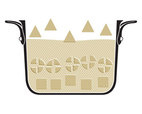Tuscan-Style Beef Stew
Tuscan beef stew (peposo), a stew made by the tilemakers of
Florence's famous Santa Maria del Fiore Cathedral Duomo, is a simple
stew of beef braised in wine, with loads of peppercorns and a head of
garlic cloves. To improve the texture and flavor of ours without veering
too far from the original, we added tomato paste and anchovies for
meatiness, powdered gelatin for body, and shallots, carrots, and herbs
for complexity. To ensure a full-bodied wine flavor, we add some wine at
the beginning of the long braise, more before reducing the sauce, and a
small amount at the end. And we did the same with the peppercorns:
cracked pepper at the start, ground pepper toward the end, and more
cracked pepper on serving.
less
less
Serves 6 to 8
We prefer boneless short ribs in this recipe because they require very little trimming. If you cannot find them, substitute a 5-pound chuck roast. Trim the roast of large pieces of fat and sinew, and cut it into 2-inch pieces. If Chianti is unavailable, a medium-bodied wine such as Côtes du Rhône or Pinot Noir makes a nice substitute. Serve with polenta or crusty bread.Ingredients
- 4 pounds boneless beef short ribs, trimmed and cut into 2-inch pieces
- Salt
- 1 tablespoon vegetable oil
- 1 (750-ml) bottle Chianti
- 1 cup water
- 4 shallots, peeled and halved lengthwise
- 2 carrots, peeled and halved lengthwise
- 1 garlic head, cloves separated, unpeeled, and crushed
- 4 sprigs fresh rosemary
- 2 bay leaves
- 1 tablespoon cracked black peppercorns, plus extra for serving
- 1 tablespoon unflavored gelatin
- 1 tablespoon tomato paste
- 1 teaspoon anchovy paste
- 2 teaspoons ground black pepper
- 2 teaspoons cornstarch
Instructions
-
1. Toss beef and 1 1/2 teaspoons salt together in bowl and let stand at room temperature for 30 minutes. Adjust oven rack to lower-middle position and heat oven to 300 degrees.
2. Heat oil in large Dutch oven over medium-high heat until just smoking. Add half of beef in single layer and cook until well browned on all sides, about 8 minutes total, reducing heat if fond begins to burn. Stir in 2 cups wine, water, shallots, carrots, garlic, rosemary, bay leaves, cracked peppercorns, gelatin, tomato paste, anchovy paste, and remaining beef. Bring to simmer and cover tightly with sheet of heavy-duty aluminum foil, then lid. Transfer to oven and cook until beef is tender, 2 to 2 1/4 hours, stirring halfway through cooking time.
3. Using slotted spoon, transfer beef to bowl; cover tightly with foil and set aside. Strain sauce through fine-mesh strainer into fat separator. Wipe out pot with paper towels. Let liquid settle for 5 minutes, then return defatted liquid to pot.
4. Add 1 cup wine and ground black pepper and bring mixture to boil over medium-high heat. Simmer briskly, stirring occasionally, until sauce is thickened to consistency of heavy cream, 12 to 15 minutes.
5. Combine remaining wine and cornstarch in small bowl. Reduce heat to medium-low, return beef to pot, and stir in cornstarch-wine mixture. Cover and simmer until just heated through, 5 to 8 minutes. Season with salt to taste. Serve, passing extra cracked peppercorns separately. (Stew can be made up to 3 days in advance.)
Technique
Cheap Wine is Fine
Early recipes for peposo relied on inexpensive Chianti, while modern versions call for a midpriced bottle (whether Chianti or a similar Tuscan wine such as Montepulciano or Brunello). We made batches using cheap ($5), midpriced ($12), and pricey ($20) Chianti, along with other varieties we often use in the kitchen: Cabernet Sauvignon, Pinot Noir, and Côtes du Rhône.
We were surprised that the stew made with the cheapest Chianti went over well with most tasters. While the midpriced wine was agreeable to everyone, there was no advantage to cooking with the expensive bottle. Highly oaked, tannic wines like Cabernet became harsh when cooked, but cheap bottles of fruitier pinot and Côtes du Rhône made good stand-ins for the Chianti.
Technique
Maximizing the Flavors from Wine and Pepper
The flavor compounds in wine and pepper can be classified by their behavior during cooking. Stable compounds don’t change, but volatile compounds evaporate, and unstable compounds break down. Over time, the result is a loss of flavor. Most recipes we found for this stew call for adding all the wine and pepper at once, at the start of a 2 1/2-hour simmer. At the end of cooking, the flavors remaining were only those of the stable compounds. By adding some of the wine and pepper 15 minutes before finishing cooking, and the remainder of wine and pepper at the end, we were able to preserve more of the volatile and unstable compounds, capturing the most fleeting, bright, fresh flavors from both the wine and the pepper.

OTHER STEWS: LESS FLAVOR
All the wine and pepper are added at the start, so many of the compounds break down or dissipate by the end of the long simmer.
TRIANGLES: Volatile compounds evaporate
CIRCLES: Unstable compounds break down
SQUARES: Stable compounds remain
All the wine and pepper are added at the start, so many of the compounds break down or dissipate by the end of the long simmer.
TRIANGLES: Volatile compounds evaporate
CIRCLES: Unstable compounds break down
SQUARES: Stable compounds remain

OUR STEW: MORE FLAVOR
We add wine and pepper in three stages to guarantee full flavor contributions from all three types of compounds.
We add wine and pepper in three stages to guarantee full flavor contributions from all three types of compounds.





















0 comentarios:
Publicar un comentario